SpaceX Crew-1
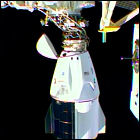 Following the first crewed test flight earlier in the year, SpaceX launches the first operational Crew Dragon flight to the International Space Station, with astronauts Michael S. Hopkins, Victor J. Glover, Sôichi Noguchi, and Shannon Walker aboard. This is also the first long-duration mission for the Crew Dragon, which will see the spacecraft remain docked to the station for several months before returning to Earth.
Following the first crewed test flight earlier in the year, SpaceX launches the first operational Crew Dragon flight to the International Space Station, with astronauts Michael S. Hopkins, Victor J. Glover, Sôichi Noguchi, and Shannon Walker aboard. This is also the first long-duration mission for the Crew Dragon, which will see the spacecraft remain docked to the station for several months before returning to Earth.
SpaceX Crew Dragon DM-2
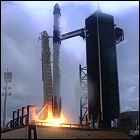 Three days after weather caused a scrub of their initial launch attempt, astronauts Douglas Hurley and Bob Behnken lift off into orbit aboard SpaceX Dragon DM-2, the second demo mission of the Crew Dragon vehicle, and the first to carry humans to space. (A previous mission, DM-1, was an uncrewed test of the Crew Dragon.) They are the first American astronauts to lift off from American soil and reach orbit since the final crew of the space shuttle lifted off in 2011. (The launch takes place six years and one day after the Crew Dragon was first unveiled.)
Three days after weather caused a scrub of their initial launch attempt, astronauts Douglas Hurley and Bob Behnken lift off into orbit aboard SpaceX Dragon DM-2, the second demo mission of the Crew Dragon vehicle, and the first to carry humans to space. (A previous mission, DM-1, was an uncrewed test of the Crew Dragon.) They are the first American astronauts to lift off from American soil and reach orbit since the final crew of the space shuttle lifted off in 2011. (The launch takes place six years and one day after the Crew Dragon was first unveiled.)
SpaceX Crew Dragon explodes in pad test
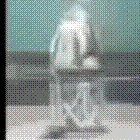 Having already visited and returned from the International Space Station in a successful uncrewed test flight, SpaceX’s Crew Dragon is set up for a critical ground test of its launch abort system, utilizing the capsule’s built-in SuperDraco engines – and explodes. While no injuries result from the explosion, the major setback results in delays to the Crew Dragon program, which would have flown the first astronauts from American soil since 2011 by the end of 2019 if all had gone as planned. SpaceX does not publicly discuss the specifics of the incident for well over a week until a company spokesman is repeatedly asked by the press about it at a publicity event for an uncrewed Falcon rocket launch.
Having already visited and returned from the International Space Station in a successful uncrewed test flight, SpaceX’s Crew Dragon is set up for a critical ground test of its launch abort system, utilizing the capsule’s built-in SuperDraco engines – and explodes. While no injuries result from the explosion, the major setback results in delays to the Crew Dragon program, which would have flown the first astronauts from American soil since 2011 by the end of 2019 if all had gone as planned. SpaceX does not publicly discuss the specifics of the incident for well over a week until a company spokesman is repeatedly asked by the press about it at a publicity event for an uncrewed Falcon rocket launch.
SpaceX shoots for the moon
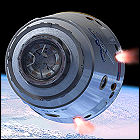 Private aerospace company SpaceX announces that a crew of two – not publicly identified by the company – have booked a private circumlunar flight scheduled to take place in 2018 aboard a SpaceX Dragon v2 capsule. The flight will utilize a free-return trajectory to the moon, around its dark side, and back to Earth, without orbiting or landing. At the time of the announcement, Dragon v2 has yet to fly into space, either with or without a crew, and the booster that would be required for this flight, the Falcon Heavy, has yet to be test-flown, either with or without a crew.
Private aerospace company SpaceX announces that a crew of two – not publicly identified by the company – have booked a private circumlunar flight scheduled to take place in 2018 aboard a SpaceX Dragon v2 capsule. The flight will utilize a free-return trajectory to the moon, around its dark side, and back to Earth, without orbiting or landing. At the time of the announcement, Dragon v2 has yet to fly into space, either with or without a crew, and the booster that would be required for this flight, the Falcon Heavy, has yet to be test-flown, either with or without a crew.
Dragon V2 unveiled
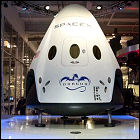 SpaceX founder Elon Musk unveils the Dragon V2 manned spacecraft, an evolution of the unmanned Dragon capsules that have been ferrying cargo to the International Space Station. With room for seven astronauts and 3-D printed engines that can output 16,000 pounds of thrust, Dragon V2 is said to be fully reusable and should be capable of landing propulsively on land rather than splashing down in a body of water. While many of the vehicles impressive specifications are revealed, no announcements are made of when NASA might permit a manned test flight to the ISS, or how far along Dragon V2 is in meeting NASA’s exacting standards for manned spacecraft.
SpaceX founder Elon Musk unveils the Dragon V2 manned spacecraft, an evolution of the unmanned Dragon capsules that have been ferrying cargo to the International Space Station. With room for seven astronauts and 3-D printed engines that can output 16,000 pounds of thrust, Dragon V2 is said to be fully reusable and should be capable of landing propulsively on land rather than splashing down in a body of water. While many of the vehicles impressive specifications are revealed, no announcements are made of when NASA might permit a manned test flight to the ISS, or how far along Dragon V2 is in meeting NASA’s exacting standards for manned spacecraft.